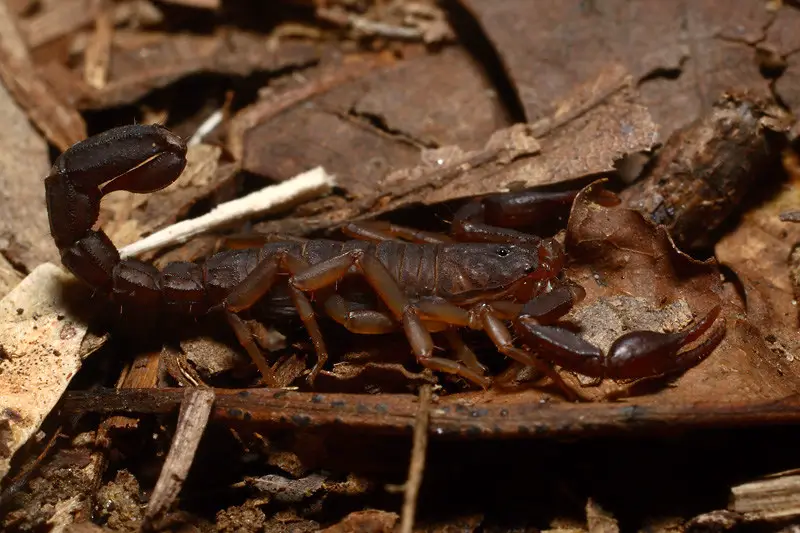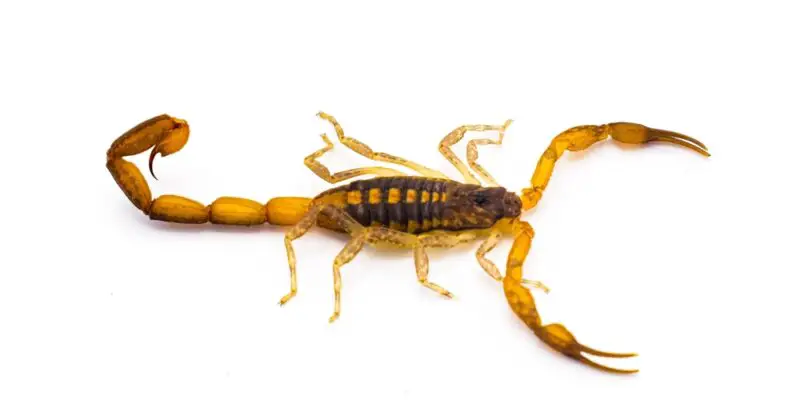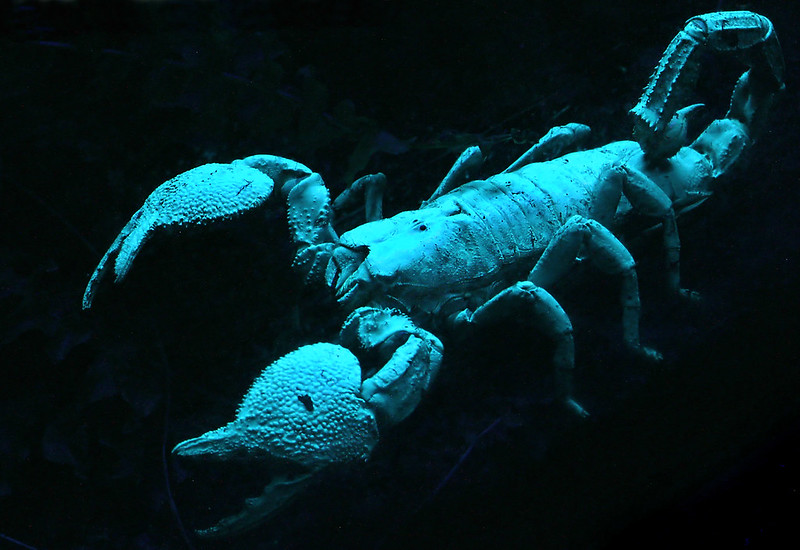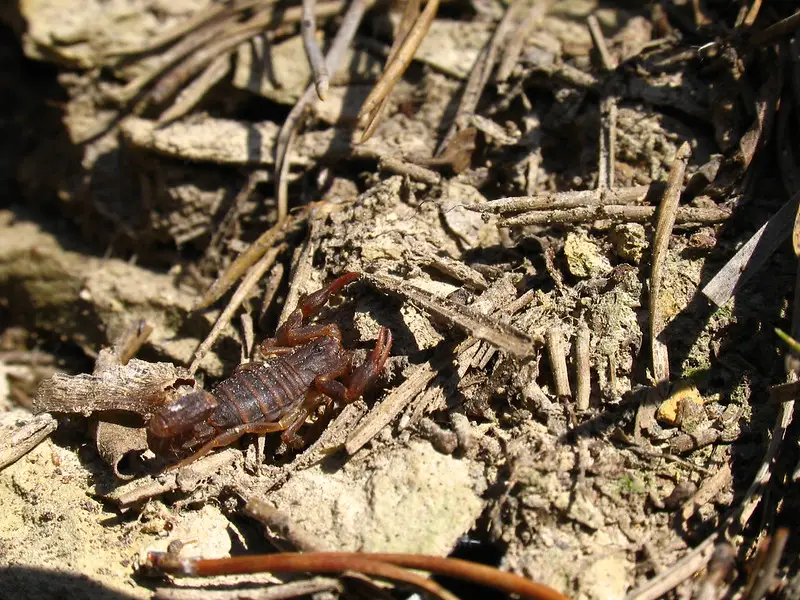Alabama’s two scorpion species are the Southern Unstriped Scorpion, which has the scientific name, (Vaejovis carolinianus) and the Hentz Striped Scorpion or (Centruroides hentzi).
Scorpions are arachnids, just as spiders are. With their proportionately large pincers and long segmented tails, scorpions look slightly like tiny land-dwelling lobsters with some distinctions. Lobsters have ten legs, while scorpions have eight, and of course, lobsters don’t have a bulbous venom-filled stinger on the end of a narrow, segmented tail, while scorpions do.
We’ll talk about both of Alabama’s scorpions in the paragraphs below.

Southern Unstriped Scorpion (Vaejovis carolinianus)
The Southern Unstriped Scorpion goes by several different common names. People use them interchangeably, depending on the locality. Southern Devil Scorpion, Southern Stripeless Scorpion, Carolina Devil Scorpion, and Plain Eastern Stripeless Scorpion are other common names that these scorpions go by.
Where Do Southern Unstriped Scorpions Live?
People associate scorpions with the dry, arid desert areas. The southwestern United States comes to mind. However, some species of scorpions are adapted to live in warm, moist areas such as the southeastern United States. Hentz striped scorpions, Florida Bark Scorpions, and Southern Unstriped Scorpions are all examples.
Besides Alabama, Southern Devil Scorpions are native to all or parts of North Carolina, South Carolina, Florida, Tennessee, Louisiana, Virginia, West Virginia, Georgia, and Mississippi.
Southern Unstriped Scorpions prefer wooded areas. Almost 70% of Alabama is wooded and thus prime Southern Unstriped Scorpion range. The Piedmont Plateau and the Appalachians of northern Alabama are examples of Southern Unstriped Scorpion habitat. Southern Unstriped Scorpions are the only type of scorpion within their range.
How Dangerous Are Southern Unstriped Scorpions?
To quote University of Tennessee entomologist Karen Vail, “The Unstriped Scorpion is tiny, and its sting is usually harmless, but some people may have an allergic reaction to the venom if stung.” See
These scorpions pack a painful sting. Nevertheless, the venom of this species is not medically dangerous to normal healthy individuals. People stung by a Southern Unstriped Scorpion report that the pain intensity is similar to a wasp sting.
On the other hand, all scorpion stings can potentially cause severe allergic reactions in some people. Click Here for the account of James Scully, a corporal in the 6th New York Cavalry of the Union Army during the Civil War. While encamped at Fair Oaks, Virginia, in 1862, Corporal Scully suffered a scorpion sting to the back of his neck. Corporal Scully nearly died due to the severity of the reaction it produced.
The only native scorpion in Virginia is Vaejovis carolinianus, commonly named the Southern Unstriped Scorpion. It’s the likely culprit that nearly killed Corporal Scully.
What Do Southern Unstriped Scorpions Look Like?
Southern Unstriped Scorpion adults are typically 1 to 1 1/2 inches (25.4 to 38.1mm) long. However, larger specimens grow to three inches (76.2mm) long. They have either a reddish or dark brown color.
Southern Unstriped Scorpion Behavior
Southern Unstriped Scorpions are nocturnal animals. During the day, they use various hiding places such as rock piles, under loose bark, and beneath leaf litter or pine straw on the forest floor and in your yard.
Around your house, you might encounter these little scorpions in old rural structures, crawl spaces, beneath leaf piles or wood piles, in laundry rooms, or even inside one of the garden gloves that you accidentally left outside overnight.
If camping in their native areas double-check your shoes, sleeping bag, clothing, and any other hiding place these scorpions might utilize. Luckily, these little guys are skittish and would rather hide from you than sting you. The only way you’ll ever be stung by one is through accidental contact.
They only use their stinger for defense or to subdue their prey. Their prey, by the way, consists of small insects and arachnids, such as spiders and other scorpions.

Hentz Striped Scorpion (Centruroides hentzi)
The Hentz striped scorpion inhabits Florida, Georgia, and Alabama. Its range in Alabama covers the southern two-thirds of the state, primarily in the coastal plain counties.
These scorpions typically measure 2 inches (5 cm) or less in total length. However, exceptionally large individuals may reach up to 2.5 inches (6.3 cm).
Hentz Striped Scorpions are yellowish brown to dark brown. They also have three greenish-yellow stripes across their backs. Their legs are translucent yellow.
Another distinguishing feature of Hentz Striped Scorpions is a tooth beneath their venom bulb. See
As with many scorpion species, male Hentz Striped Scorpions tend to be slenderer in build, with an elongated tail.
Like Southern Unstriped Scorpions, Hentz Striped Scorpions hide during the day and come out at night. In daylight hours, they hide in stone crevasses, leaf litter, and in the sheltered dark places around your home, such as crawl spaces.
The following section discusses scorpion detection, whether around your home or campsite.

How to Check for Scorpions
As stated above, scorpions are nocturnal carnivores. During the day, they hide out. Crawl spaces, wood stacks, rocky hillsides, and leaf-covered areas are all examples of likely hiding spots.
To detect the presence of scorpions, it’s a good idea to search for them after dark.
Scorpions have compounds in their exoskeletons that glow under ultraviolet light. To see them after dark, in your yard, or camping in an area where scorpions are active, the best way to find them is with a UV flashlight. Use the ultraviolet light to scan your yard or campsite after dark. The scorpions will glow a bright blueish color.
Remember that the darker the night, the more the scorpion will glow. In other words, they are more luminous on a new moon night, for example. What’s more, campfires and other light sources will reduce the effectiveness of your ultraviolet light source.
One last thing to remember is that UV light radiating in the 320 to 400 nm range isn’t overly harmful to your vision. However, if you choose to use a UV light source that produces shorter wavelengths, you’ll want also to use eye protection.
Interesting Scorpion Facts
- Even fossilized scorpions glow under ultraviolet light.
- Fossilized remains of Jaekelopterus rhenaniae, an ancient giant sea scorpion measured over 8 feet long.
First Aid for Scorpion Stings
- Clean the sting site with mild soap and water.
- Apply a cold compress to the affected area.
- Avoid eating or drinking if you are having trouble swallowing.
- Treat with an over-the-counter pain reliever as needed.
- Make sure that the affected individual’s Tetanus vaccination is up to date.
- If any severe symptoms described in the last paragraph manifest, seek immediate medical help. See
The good news is that two types of scorpions in Alabama have venomous stings that are no more medically significant than a bee sting. Nevertheless, in rare cases, scorpion venom has the potential to cause severe reactions.
Serious allergic reactions such as anaphylactic shock are a possibility. If you have blurred vision, muscle twitching, intense pain, or difficulty breathing after experiencing a scorpion sting, seek immediate medical attention.
You might also like:
Recent Posts
The only venomous snakes in Washington State are Northern Pacific Rattlesnakes. The Northern Pacific Rattlesnake (Crotalus oreganus oreganus) is a sub-species of the Western Rattlesnake. Anyone...
Skunks are not classified as true hibernators. But they go into a state of torpor when the weather gets cold. Skunks are light sleep hibernators, along with opossums, bears, and raccoons. ...

